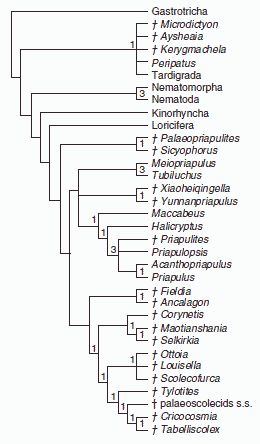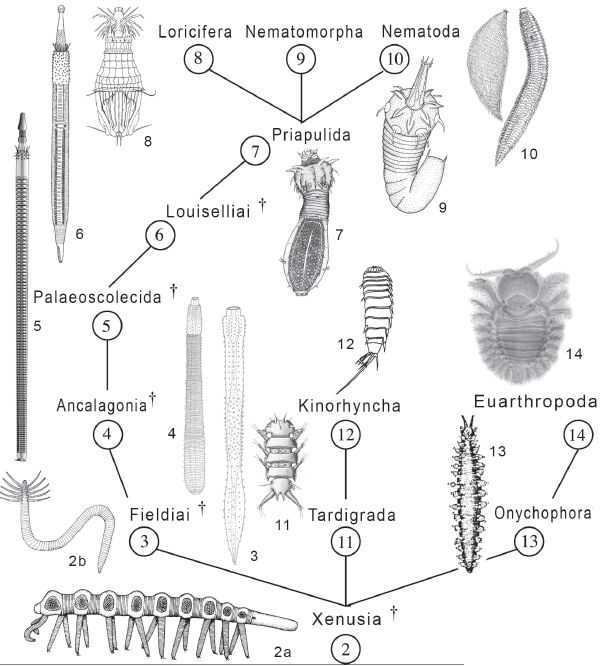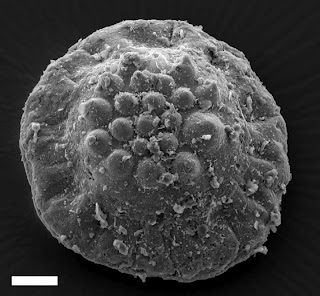| Palaeoscolecida | ||
| Ecdysozoa | Palaeoscolecida |
| Scalidophora | Ecdysozoa | Priapozoa | ||
| Ecdysozoa | Nematoida |
|
Abbreviated Dendrogram
Bilateria
├─Deuterostomia
└─┬─Spiralia
│
└─Ecdysozoa = paraphyletic Scalidophora?
├─Markuelia
├─Kinorhyncha
╞═Palaeoscolecida
│ ├─Maotianshania
│ └─┬─Cricocosmia
│ └─Palaeoscolex
╞═Priapozoa
│ └─┬─Priapulida
│ └─┬─Sirilorica
│ └─ Loricifera
└─┬─Nematoida
└─Panarthropoda
|
Contents
Overview |
|
|
Palaeoscolecidans were a successful group of burrowing worms in the early Palaeozoic, when they were probably even more significant than the annelids. Originally interpreted as annelids, the segmented appearance is apparently only superficial, and results from alternating bands of larger and smaller plates (Ivantsov & Wrona, 2004). Well-preserved specimens from the Chengjiang Fauna possess an anterior spiny proboscis like that of the modern priapulids, and palaeoscolecidans have most often been regarded as priapozoans. Other authors have suggested relationships with the modern nematomorphs, or as stem-panarthropods (Han et al., 2007). At the very least, a position within the Ecdysozoa, the clade uniting these three groups, seems well-established. - CKT080122
 Parsimony analyses of priapulids and related fossil and extant cycloneuralians by Harvey et al 2010 This cladogram gives the strict consensus of most parsimonious trees. Numbers reflect Bremer support for respective nodes as determined by the Double Decay Analysis.. |
Dzik & Krumbiegel 1989, Budd & Jensen 2000, Budd 2001, Conway Morris & Peel 2010 propose a palaeoscolecid-like form as the common cycloneuralian or ecdysozoan ancestor. Harvey et al 2010 using a traditional cladistic morphological approach, tested and rejected the hypothesis that palaeoscolecids reresent ancestral ecdysozoans and found them instead to be standard Priapulids. Their detailed analysis recovered a monophyletic Cycloneuralia and Panarthropoda, with the Loricifera occupying a transitional position between the Kinorhyncha and the Priapulida (see also the cladograms in Dong et al 2005). Their cladogram, which includes many fossil taxa, is shown at the right.
With studies of this kind however there is always the problem of distinguishing between primitive and derived features. Palaeoscolecids may well share primitive or ancestral ecdysozoan traits with priapozoans, causing the two to cluster together in morphological analyses, or for one to be subsumed under the other (seeing how they may both be paraphyletic or even polyphyletic groups this would not be unlikely). Without knowledge of soft parts (although some information can be retrieved from lagerstatten) or genome information and other characters well represented in extant taxa, determining the basal relationships between these early worms is always going to be problematic. Not surprsingly, researchers in this field arrive at very different conclusions, this being even more the case when different methodologies and starting assumptions are used.
For example Zhuravlev et al 2011 note that on the one hand the palaeoscolecidans possess Cephalorhynchan (= Scalidophora + Nematoida) characteristics such as a terminal mouth and an anus, an invertible proboscis with pointed scalids, a thick integument of diverse plates, sensory papillae and caudal hooks. But they also share a number of features with Cambrian lobopods (the paraphyletuic class Xenusia), such as a thick integument of diverse plates. They argue that cephalorhynchs are descendents of xenusians, which lost walking appendages and acquired a retractable proboscis and worm-like body as an adaptation to a burrowing lifestyle. The Cambrian Facivermis might represent an intermediate semi-burrowing form, in the process of losing its limbs. Tardigrades, onychophorans and anomalocaridids (making up a paraphyletic panarthropoda, leading to the arthropods) represent other xenusian descendents, which evolution interstitial, surface-dwelling and swimming lifestyles, respectively. This is illustrated by the following diagram (some taxa have been removed, specifically .anomalocarids as ancestors to pycnogonids, which makes less sense then the hypothesis that they represent a paraphyletic assemblage leading to the true arthropods ):
 General phylogeny of the Ecdysozoa 2a.xenusian Microdictyon sinicum Chen, Hou and Lu, Lower Cambrian (modified from Hou and Bergstrom, 1995); 2b.xenusian Facivermis yunnanicus Hou and Chen, Lower Cambrian (modified from Delle Cave and Simonetta, 1991); 3.Fieldia lanceolata Walcott, Middle Cambrian (modified from Conway Morris, 1977); 4.Ancalagon minor Walcott, Middle Cambrian (modified from Conway Morris, 1977); 5.palaeoscolecid Cricocosmia jinningensis Hou and Sun, Lower Cambrian (modified from Han et al., 2007); 6.Louisella pedunculata Walcott, Middle Cambrian (modified from Conway Morris, 1977); 7.priapulid larva Halicryptus spinulosus von Seibold, extant (modified from Malakhov and Adrianov, 1995); 8.loriciferan larva Pliciloricus ornatus Higgins and Kristensen, extant (modified from Malakhov and Adrianov, 1995); 9.nematomorph larva Gordionus senkovi Malakhov and Spiridonov, extant (modified from Malakhov and Adrianov, 1995); 10.nematodes Greeffiella (left) and Criconema (right), extant (modified from Brusca and Brusca, 2003); 11.tardigrade Stygarctus abornatus McKirdy, Schmidt and McGinty-Bayly, extant (modified from McKirdy et al., 1976); 12.kinorhynch Centroderes eisigii Zelinka, extant (modified from Malakhov and Adrianov, 1995); 13.onychophoran Peripatopsis moseleyi Wood-Mason), extant (modified from Ruhberg in Monge-Najera and Hou, 1999); 14.larval euarthropod Ascalaphus sp., extant; Caption and diagram by Zhuravlev et al 2011. General phylogeny of the Ecdysozoa 2a.xenusian Microdictyon sinicum Chen, Hou and Lu, Lower Cambrian (modified from Hou and Bergstrom, 1995); 2b.xenusian Facivermis yunnanicus Hou and Chen, Lower Cambrian (modified from Delle Cave and Simonetta, 1991); 3.Fieldia lanceolata Walcott, Middle Cambrian (modified from Conway Morris, 1977); 4.Ancalagon minor Walcott, Middle Cambrian (modified from Conway Morris, 1977); 5.palaeoscolecid Cricocosmia jinningensis Hou and Sun, Lower Cambrian (modified from Han et al., 2007); 6.Louisella pedunculata Walcott, Middle Cambrian (modified from Conway Morris, 1977); 7.priapulid larva Halicryptus spinulosus von Seibold, extant (modified from Malakhov and Adrianov, 1995); 8.loriciferan larva Pliciloricus ornatus Higgins and Kristensen, extant (modified from Malakhov and Adrianov, 1995); 9.nematomorph larva Gordionus senkovi Malakhov and Spiridonov, extant (modified from Malakhov and Adrianov, 1995); 10.nematodes Greeffiella (left) and Criconema (right), extant (modified from Brusca and Brusca, 2003); 11.tardigrade Stygarctus abornatus McKirdy, Schmidt and McGinty-Bayly, extant (modified from McKirdy et al., 1976); 12.kinorhynch Centroderes eisigii Zelinka, extant (modified from Malakhov and Adrianov, 1995); 13.onychophoran Peripatopsis moseleyi Wood-Mason), extant (modified from Ruhberg in Monge-Najera and Hou, 1999); 14.larval euarthropod Ascalaphus sp., extant; Caption and diagram by Zhuravlev et al 2011. |
Alternatively, the palaeoscolecidans may simply be a separte line of early minearlised ecdysozoa, and the similarities with teh priapulids may be shared primitive ecdysozoan features. Palaeoscolecidans, priapulids, lobopods, and other groups would be different lineages in a rich early flowering of Cambrian ecdysozoans, equivalent to, say, the great diversity of early Paleozoic arachnomorphs (trilobites, tribitomorphs, and chelicerates) in comparison with teh impoverised fauna of the late Paleozoic through to recent. MAK120420
Palaeoscolecida: Conway Morris & Robinson, 1986 : Palaeoscolex, Cricocosmia, Tabelliscolex, etc
Early Cambrian to late Silurian
Phylogeny: Basal or stem Priapozoa/Scalidophora/Ecdysozoa? Paraphyletic or polyphyletic? : Maotianshania + (Cricocosmia + Palaeoscolex)
Characters: spiny introvert, segmental array of sclerites in organised bands (Conway Morris & Peel 2010)

Comments: Palaeoscolecids bear an annulated trunk ornamented with circular patterns of phosphatic tesselating plates; a layered cuticle; and an armoured proboscis. They are usually a few centimetres in length. There is no one character that unites the palaeoscolecids as a clade (indeed they are likely paraphyletic), and few individual specimens contain all characteristic palaeosolecid traits. (Harvey et al 2010) - Wikipedia.
Note: Comment: Unlike other animals known from isolated armour plates (scleritomes) , the Palaeoscolecida were actually known as entire animals long before their dermal armation was described, but the said armation was described as isolated problematic fossils before a connection was made between the animal and its armour (Ivantsov & Wrona, 2004) The photo at the right shows one of the isolated sclerites, originally described under the name Hadimopanella. Palaeoscolecid sclerites are round and button-like, with a central array of nodules that vary in different species from low and rounded to higher and pointed. Opinions on the nature of these microfossils (to appreciate how small they are, the scale bar on the photo above represents 0.03 mm) varied from some sort of dermal armour to the remains of reproductive cysts (Repetski, 1981). The dermal armour theory, of course, won out when the connection was made between the isolated sclerites and ornamentation on the compressed body fossils almost simultaneously by different authors in 1989 (Ivantsov & Wrona, 2004). CKT080122
Maotianshania cylindrica: Sun & Hou, 1987
Horizon: Early Cambrian of China (Chengjiang)
Phylogeny: Palaeoscolecida : (Cricocosmia + Palaeoscolex) + *
Comments: May be intermediate between priapozoa and palaeoscolecids because in addition to a typical proboscis, this species has a trunk with numerous small sclerites. But unlike palaeoscolecidd these have a rather uniform distribution, unlike the organised bands representative of most palaeoscolecidans. (Conway Morris & Peel 2010). It may well be therefore that this species belongs to a different group, which may or may not be related to true palaeoscolecids MAK120422
Cricocosmia jinningensis Hou & Sun, 1988
Horizon: Early Cambrian of China (Chengjiang)
Phylogeny: Palaeoscolecida : Maotianshania + (Palaeoscolex + *)
Palaeoscolex: Palaeoscolex piscatorum Whittard 1953 (Type species ); Palaeoscolex antiquus Glaessner, 1979. (Early Cambrian of Australia) (Glaessner 1979); Palaeoscolex sinensis Hou & Sun, 1988 (Early Cambrian (Chengjiang) of China); Palaeoscolex lubovae Ivantsov & Wrona 2004, P. spinosus Ivantsov & Wrona 2004, (both Early Cambrian of eastern Siberia) (Ivantsov & Wrona2004)
Early Cambrian of Australia, Bohemia, China, and Siberia
Phylogeny: Palaeoscolecida: Maotianshania + (Cricocosmia + *)
Comments: originally described as an annelid. A number of species, perhaps a wastebasket taxon?
Phosphatized palaeoscolecid cuticle fragments from the Early Cambrian Sinsk Formation of the (Siberian Platform) at the Achchagyy Tuoydakh fossil-Lagerstatte show remarkably well preserved arrays of plates and platelets identical to widely reported isolated sclerites assigned to Hadimopanella, Kaimenella, Milaculum, and Utahphospha. Some of the described cuticular trunks exhibit distinction between the dorsal and ventral sides: nodular sclerites occur on the dorsal and spiny sclerites on the ventral sides of the worm body, suggesting adaptation for a level-bottom, vagile benthic and probably epifaunal mode of life. Sclerites recorded with microplates accreted into the basal brim imply that the more complex sclerite structure bearing a series of nodes was derived from simple small sclerites with a single node. There is little biostratigraphic utility to these isolated sclerites, as the same morphology occur in different worms, and different sclerites may occur in one scleritome. - from the abstract by Ivantsov & Wrona2004 MAK120422
Links: Marine Species, Palaeoscolex antiquus
| Scalidophora | Ecdysozoa | Priapozoa |
page MAK120416, last revised MAK120422. All text by MAK (M. Alan Kazlev) is Creative Commons Attribution . Text by CKT © Christopher Taylor. Wkipedia quoted material creative commons/gnu opensource license. Other content copyright respective authors or publishers